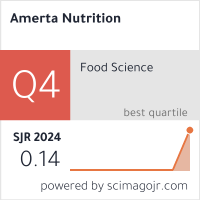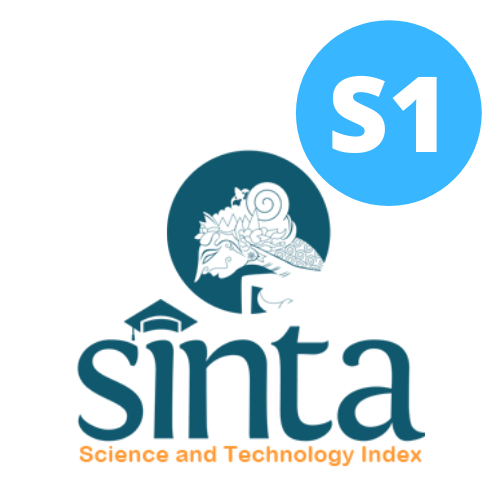Studi Karakteristik Siswi Penerima Program Tablet Tambah Darah sebagai Antisipasi Stunting
Studi Karakteristik Siswi Penerima Program Tablet Tambah Darah sebagai Upaya Pencegahan Anemia pada Remaja
Unduhan
Latar Belakang: Upaya percepatan penurunan stunting melibatkan intervensi gizi spesifik dan sensitif. Remaja putri (siswi) sekolah merupakan kelompok sasaran dalam penurunan stunting melalui pencegahan anemia. Program Suplementasi Tablet Tambah Darah (TTD) merupakan intervensi gizi spesifik dalam pencegahan anemia pada remaja putri.
Tujuan: Penelitian ini bertujuan untuk mengkaji karakteristik siswi sebagai penerima program TTD.
Metode: Desain penelitian ini adalah cross sectional dengan melibatkan sebanyak 123 siswi dari 12 sekolah menengah atas negeri/sederajat di Wilayah Kabupaten Cianjur, Provinsi Jawa Barat. Karakteristik siswi terdiri dari pengetahuan siswi tentang anemia dan kepatuhan terhadap suplementasi TTD.
Hasil: Pengetahuan siswi tentang anemia sebagian besar (61,8%) berada pada kategori rendah, 30,9% siswi berpengetahuan sedang, dan 7,3% siswi berpengetahuan tinggi. Siswi (44,7%) mengetahui cara untuk mendeteksi anemia adalah melalui pemeriksaan kadar hemoglobin dalam darah. Sebanyak 59,3% dan 51,2% siswi mengetahui penyebab anemia adalah kurang asupan zat besi dan kehilangan banyak darah akibat menstruasi. Sebanyak 60-80% siswi telah mengenali gejala dan tanda yang umum dari anemia. Sebagian besar siswi (76,8%) menerima TTD setiap minggu dan sebanyak 41,2% siswi mengakui patuh dalam mengonsumsi TTD dengan tujuan agar tidak anemia (85,1%), sisanya 23,4% dan 14,9% karena diarahkan oleh Guru dan Petugas Puskesmas. Sebanyak 58,8% siswi tidak patuh dengan alasan takut terhadap efek samping, rasa tablet, faktor lupa, dan sudah merasa sehat.
Kesimpulan: Program suplementasi TTD sudah berjalan dan tepat sasaran, namun pemahaman siswi terhadap tujuan, manfaat, dan kepatuhan terhadap suplementasi TTD perlu ditingkatkan.
UNICEF. The state of the world's children 2019 – children, food and nutrition: Growing well in a changing world. https://www.unicef.org/reports/state-of-worlds-children-2019 (2019).
WHO. Weekly iron and folic acid supplementation as an anaemia-prevention strategy in women and adolescent girls: lessons learnt from implementation of programmes among non-pregnant women of reproductive age. https://www.who.int/publications/i/item/WHO-NMH-NHD-18.8 (2018).
The Global Nutrition Report. 2018 Global Nutrition Report: Country Nutrition Profiles. https://globalnutritionreport.org/resources/nutrition-profiles/asia/south-eastern-asia/indonesia/ (2018).
Kementerian Kesehatan RI. Hasil Utama Riset Kesehatan Dasar 2018. https://kesmas.kemkes.go.id/ (2018).
Kementerian Kesehatan RI. Studi Status Gizi Balita Terintegrasi SUSENAS 2019. (2019).
Kementerian Kesehatan RI. Buku Saku Hasil Studi Status Gizi Indonesia (SSGI) Tahun 2021. (Kemenkes RI, 2021).
Kementerian Kesehatan RI. Rencana Strategis Kementerian Kesehatan Tahun 2015-2019. https://ppid.kemkes.go.id/uploads/img_5cd07f7e6d039.pdf (2015).
[TNP2K] Tim Nasional Percepatan Penanggulangan Kemiskinan (the National Team for the Acceleration of Poverty Reduction). 100 Kabupaten/Kota Prioritas Untuk Intervensi Anak Kerdil/Stunting (100 Districts/City of Priority for the Intervention in Stunting). (2017).
Kementerian Kesehatan RI. Pedoman Pencegahan dan Penanggulangan Anemia pada Remaja Putri dan Wanita Usia Subur (WUS). (Kemenkes RI, 2018).
Salam, R. A. et al. Interventions to Improve Adolescent Nutrition: A Systematic Review and Meta-Analysis. J. Adolesc. Heal. Off. Publ. Soc. Adolesc. Med. 59, S29–S39 (2016).
Gosdin, L. et al. A School-Based Weekly Iron and Folic Acid Supplementation Program Effectively Reduces Anemia in a Prospective Cohort of Ghanaian Adolescent Girls. J. Nutr. 151, 1646–1655 (2021).
Briawan, Dodik; Khomsan, Ali; Ekayanti, Ikeu; Dewi, M. Report of Baseline Survey for an Improved IFA Supplementation Program for 15 to 19 Years of Age School going Adolescent Girls (MITRA Youth) in East Java and East Nusa Tenggara Provinces in Indonesia. (2018).
Permatasari, T., Briawan, D. & Madanijah, S. Efektifitas Program Suplementasi Zat Besi pada Remaja Putri di Kota Bogor. Media Kesehat. Masy. Indones. 14, 1–8 (2018).
Andriastuti, M., Ilmana, G., Nawangwulan, S. A. & Kosasih, K. A. Prevalence of anemia and iron profile among children and adolescent with low socio-economic status. Int. J. Pediatr. Adolesc. Med. 7, 88–92 (2020).
Kim, J. Y. et al. Relationship between socioeconomic status and anemia prevalence in adolescent girls based on the fourth and fifth Korea National Health and Nutrition Examination Surveys. Eur. J. Clin. Nutr. 68, 253–258 (2014).
Sumarlan, Eka S; Windiastuti, Endang; Gunardi, H. Iron Status, Prevalence and Risk Factors of Iron Deficiency Anemia Among 12 to 15-Year-Old Adolescent Girls from Different Socioeconomic Status in Indonesia. Makara J. Heal. Res. 22, 46–52 (2018).
Seminar, A. U. et al. Awareness about Anaemia and Weekly Iron-Folic Acid Supplementation (WIFAS) among School-Going Adolescent Girls and Parents in East Java and East Nusa Tenggara, Indonesia. J. Nutr. Sci. Vitaminol. (Tokyo). 66, S111–S117 (2020).
Apriningsih, Madanijah, S., Dwiriani, C. M. & Kolopaking, R. Determinant of Highschool Girl Adolescent' Adherence to Consume Iron Folic Acid Supplementation in Kota Depok. J. Nutr. Sci. Vitaminol. (Tokyo). 66, S369–S375 (2020).
Maulida, F., Setiarini, A. & Achadi, E. L. Evaluation of The Implementation of Fe Tablets for Adolescent Girl in 2019 at Pekanbaru City. Amerta Nutr. 5, 19–29 (2021).
WHO. Guideline: Intermittent iron folic acid supplementation in menstruating women. (2011).
Sedlander, E., Long, M. W., Bingenheimer, J. B. & Rimal, R. N. Examining intentions to take iron supplements to inform a behavioral intervention: The Reduction in Anemia through Normative Innovations (RANI) project. PLoS One 16, e0249646 (2021).
Handayani, IGAAD; Suantara, IMR; Sugiani, P. Suplementasi Tablet Tambah Darah efektif Meningkatkan Kadar Hemoglobin Darah Remaja Putri Di Tampaksiring Kabupaten Gianyar (Iron tablet supplementation effectively increases haemoglobin level in adolescent girls in Tampaksiring Gianyar District). JIG 4, 111–118 (2013).
Alfiah, E. et al. Coverage and Adherence of Weekly Iron Folic Acid Supplementation among School Going Adolescent Girls in Indonesia. J. Nutr. Sci. Vitaminol. (Tokyo). 66, S118–S121 (2020).
WHO. Global Accelerated Action for Health of Adolescents (AA-HA). (2017).
Roche, M. L. et al. A Community-Based Positive Deviance/Hearth Infant and Young Child Nutrition Intervention in Ecuador Improved Diet and Reduced Underweight. J. Nutr. Educ. Behav. 49, 196-203.e1 (2017).
Rimal, R. N. et al. Iron and folic acid consumption and changing social norms: cluster randomized field trial, Odisha, India. Bull. World Health Organ. 99, 773–782 (2021).
Ganjoo, R. et al. Improving iron folic acid consumption through interpersonal communication: Findings from the Reduction in Anemia through Normative Innovations (RANI) project. Patient Educ. Couns. 105, 81–87 (2022).
Hak Cipta (c) 2022 Amerta Nutrition

Artikel ini berlisensiCreative Commons Attribution-ShareAlike 4.0 International License.
AMERTA NUTR by Unair is licensed under a Creative Commons Attribution-ShareAlike 4.0 International License.
1. The journal allows the author to hold the copyright of the article without restrictions.
2. The journal allows the author(s) to retain publishing rights without restrictions
3. The legal formal aspect of journal publication accessibility refers to Creative Commons Attribution Share-Alike (CC BY-SA).
4. The Creative Commons Attribution Share-Alike (CC BY-SA) license allows re-distribution and re-use of a licensed work on the conditions that the creator is appropriately credited and that any derivative work is made available under "the same, similar or a compatible license”. Other than the conditions mentioned above, the editorial board is not responsible for copyright violation.












































